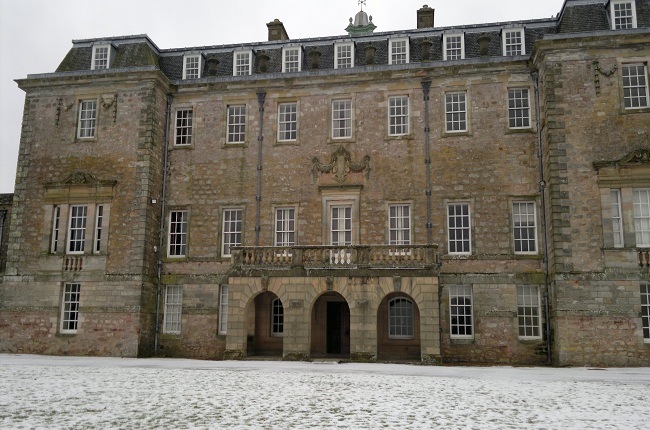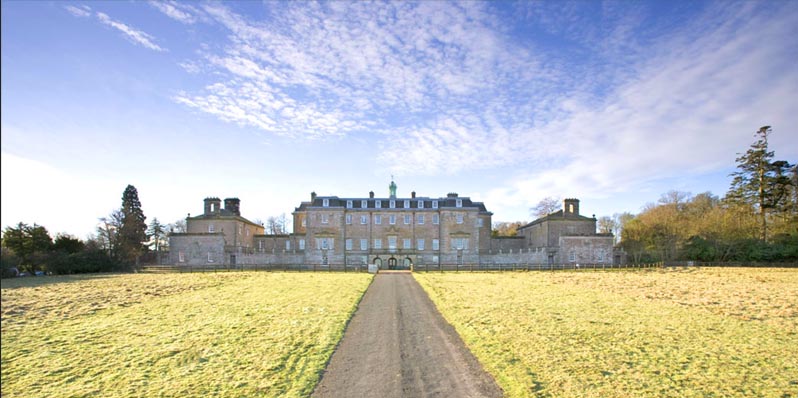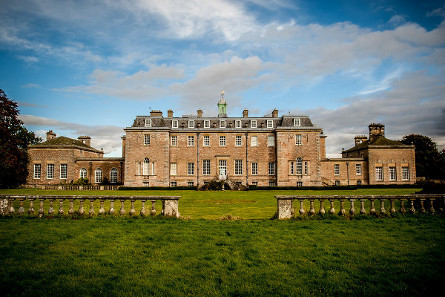Marchmont House lies on the east side of the small town of Greenlaw, and near the former village of Polwarth in Berwickshire, in the Scottish Borders area of Scotland. It is about five miles (8 km) south west of Duns, about 19 miles (31 km) west of Berwick-upon-Tweed and about 40 miles (64 km) south east of Edinburgh. Situated in a gently undulating landscape, the estate is intersected by Blackadder Water, and its tributary burns. With the Lammermuir Hills to the north and views towards the Cheviot Hills in the south, this part of Berwickshire, sometimes referred to as the Merse, is very scenic and contains rich and fertile agricultural land.
The Palladian house was built by Hugh Hume-Campbell, 3rd Earl of Marchmont, in 1750. His bust, albeit a plaster copy, sits on a wall bracket in the saloon. The original is in Mellerstain House, another important Borders house which has intimate historical links with Marchmont. Before its completion the family lived in Redbraes Castle, the diminutive ruins of which can be seen in front of the present house by the steading. At Redbraes lived Sir Patrick Hume of Polwarth, later Patrick Hume, 1st Earl of Marchmont. His portrait by William Aikman, c 1720, and framed by a George II period gilt mirror, hangs above the chimneypiece in the drawing room. It is not coincidence that a near identical portrait hangs in the Music Room at Mellerstain.
Having been implicated in the Rye House Plot, Sir Patrick was forced into hiding in the vaults of Polwarth Church, close to the house. His daughter, Lady Grisell Hume, (later Grizel Baillie) smuggled food to him, and her well trod path from Redbraes to the church became known as ‘Lady’s Walk’. Lady Grisell’s life was an epic story of selfless bravery, for which she eventually found reward in a long and happy life. She wrote her memoirs which were handed down to her daughter, who in turn transcribed them for future generations. In them she tells of the fearful chapters she endured as a young teenager aiding her father and family. Sir Patrick fled to Holland in 1684, again assisted by his daughter, but made a glorious return with King William who reinstated their lands and created Sir Patrick the first Earl of Marchmont in 1697. He was later made Lord Chancellor, and then in 1698 he was elevated to "the highest official position in the kingdom, that of the King's High Commissioner to the Parliament" The king's gratitude was symbolised by his granting Sir Patrick permission to place an orange, bearing the Imperial crown, in his coat of arms. An example of this can be seen clearly on the carved coat of arms on the east gable of Polwarth church restored by, and once a self-imposed prison of, Sir Patrick.
Thoughts of replacing the family seat of Redbraes Castle with a new and grand house started long before the foundations were laid. The planting of the Great Avenue was begun in 1726 when 10,000 Dutch elms were ordered to line the avenue which at 1.3 miles (2.1 km) long is thought to be the longest in Scotland. Still in existence (albeit with other trees, mostly beech, planted after the great gales of 1881) it leads north east from the front of the house and terminates at the Doocot, built in 1749 by James Williamson.
There are about 390 acres (1.6 km2) of designed landscape, more or less in the same format as originally laid out. The gardens were originally arranged formally and to the south and south west or rear of the house. The plans can be seen in the first edition OS map of 1857. A ha-ha separates the formal gardens from the deer park to allow a seamless view leading from the tightly arranged garden through into the wilder, but still man-ordered, policy of the deer park. Here there are many mature trees, some thought to date from the late 18th century. In 1962 the tallest oak in Britain was recorded at Marchmont. Specimen trees surround the gardens and include a fine cutleaf beech, an arbutus, a Wellingtonia, cedars and hollies.
In the trees, behind the house to the north west, can be seen a pets’ cemetery. Closer inspection shows a neatly laid out arrangement of 23 headstones bearing the names of fox hounds. Dating from 1866 carved with the name "Spot" to 1891 with "Little Boy", the stones relate to the Patrick Hume’s three packs of hounds.
In addition to the Doocot already mentioned, other interesting constructions are the steading built around a courtyard, which date to the 17th century; the yard clock dated 1746; the associated but later three-storey tower; the arched concrete span over garages, and the William Adam designed balustraded bridge of 1759, which connected the main entrance route from the north (named the Green Ride) to the approach to the house. The walled gardens laid out in the 18th century to the south of the house incorporate a magnificent greenhouse and associated structures built by Mackenzie and Moncur in 1915[9] after designs attributed to Lorimer.












